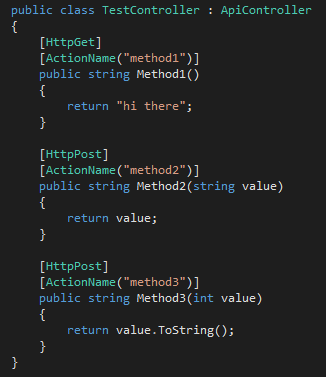If you’ve ever worked with webservices, chances are you’ve run into WSDL (http://www.w3.org/TR/wsdl). In the webapi world you don’t get so much out the box – this is where swagger can help expose test methods, documentation and a lot more.
For asp.net projects you can make use of a library: https://github.com/domaindrivendev/Swashbuckle. Install via nuget and you get a UI allowing a configurable interaction with all the webapi methods in your solution:
The test controller and methods:

All pretty simple stuff – how about if you want to secure things?
An example scenario might be you only want swagger accessible if you are visiting via http://localhost (or a loopback url).
It’s straight forwards if you implement a custom webapi DelegatingHandler.
|
1 2 3 4 5 6 7 8 9 10 11 12 13 14 15 16 17 18 19 20 21 22 23 24 25 26 27 28 29 30 31 32 33 34 35 |
using System.Net.Http; using System.Security; using System.Threading; using System.Threading.Tasks; namespace SwaggerDemo.Controllers.Api { public class SwaggerAccessHandler : DelegatingHandler { protected override async Task<HttpResponseMessage> SendAsync( HttpRequestMessage request, CancellationToken cancellationToken) { if (request.RequestUri.ToString().ToLower().Contains("/swagger/")) { if (IsTrustedRequest(request)) { return await base.SendAsync(request, cancellationToken); } else { throw new SecurityException(); } } return await base.SendAsync(request, cancellationToken); } private bool IsTrustedRequest(HttpRequestMessage request) { //concoct the logic you require here to determine if the request is trusted or not // an example could be: if request.IsLocal() return true; } } } |
This then needs wiring into the webapi request pipelines. In your WebApiConfig file (OTB in your solution in the folder: App_Start) add:
|
1 |
config.MessageHandlers.Add(new SwaggerAccessHandler()); |
In the TestController example above we had several httpPost methods available – to enable this functionality you need to allow the routes to include the {action} url chunk.
|
1 2 3 4 5 |
config.Routes.MapHttpRoute( name: "DefaultApiWithAction", routeTemplate: "api/{controller}/{action}/{id}", defaults: new { id = RouteParameter.Optional } ); |
Azure webapi’s are now compatible with swagger – see https://azure.microsoft.com/en-gb/documentation/articles/app-service-dotnet-create-api-app/ for more info.

Are you doing this with Sitecore 8.2? I’m trying to figure out where to initialize swagger – any example pipeline methods would be useful thanks.
FYI this was in a standalone MVC project.
In the past when I’ve used WebApi within Sitecore projects you still have access to the same WebApiConfig.cs config file (have a look in App_Start). Does this give you the hook you wanted?
Thanks Boro. I figured out that I need kick swagger off at the same (just after) I register the WebApi routes – i.e. in pipeline processor. However I now get the following error when trying to access my docs –
“ExceptionMessage”:”Not supported by Swagger 2.0: Multiple operations with path ‘sitecore/shell/api/ct/Action/Review’
Is there a way to tell swagger to only document certain controller (or certain routes)?